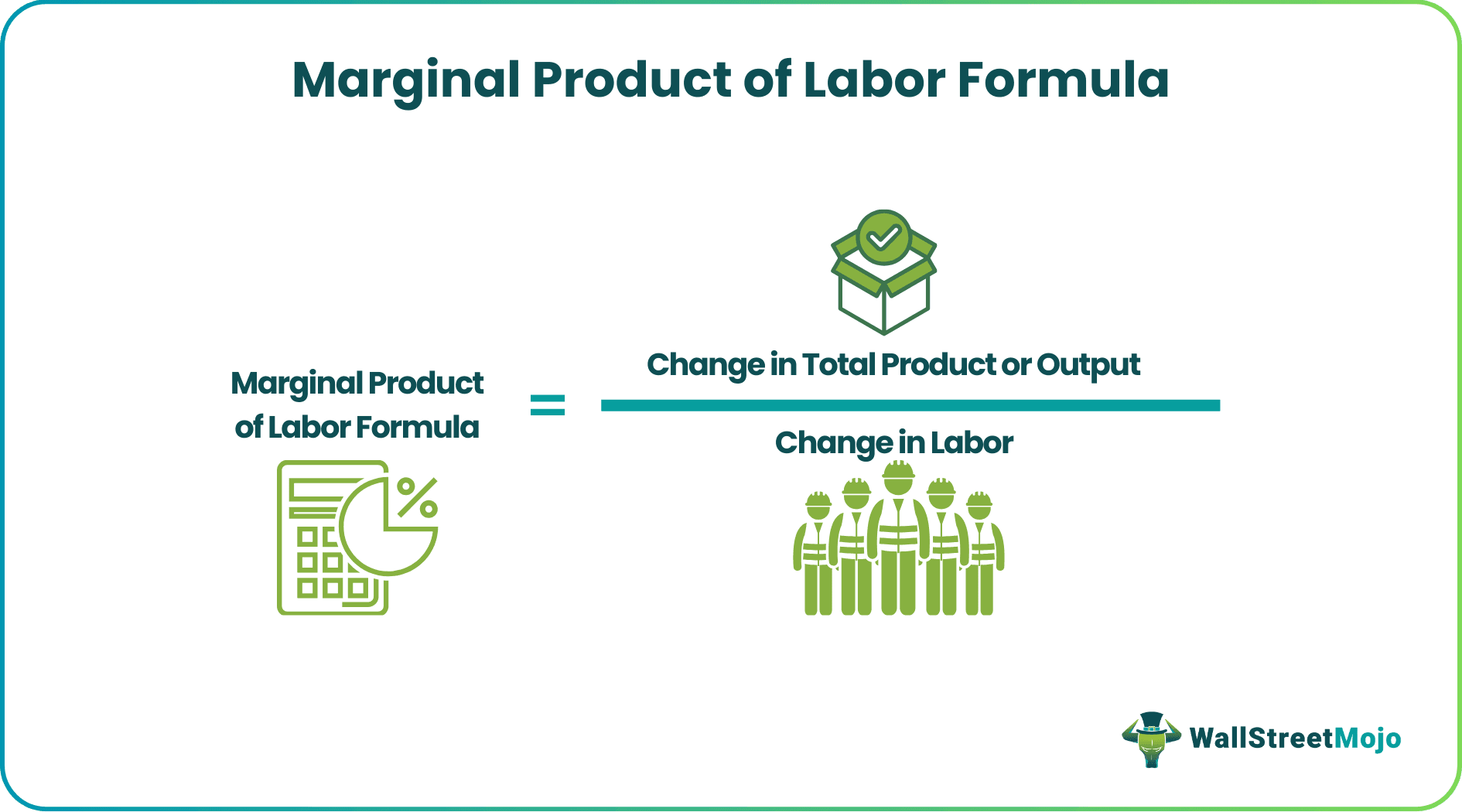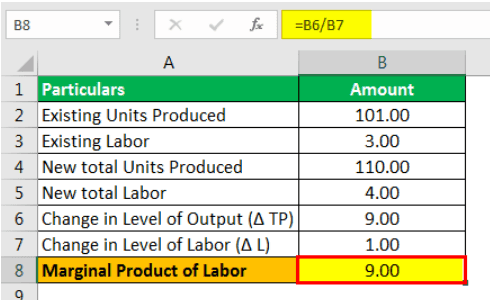Table Of Contents
Formula to Calculate Marginal Product of Labor (MPL)
Marginal Product of Labor Formula is the formula that calculates the change in the level of the output of the company when there is the addition of a new employee, and according to the formula, Marginal Product of Labor is calculated by dividing change in the value of the total product by the change in the labor.
The formula for calculating the Marginal Product of labor (MPL) is represented below.
Marginal Product of Labor = Δ TP / Δ L

Where,
- Δ TP is changed in total product or output
- Δ L is the change in labor
It depicts the additional output when 1 unit of labor or additional new employee is hired or added to the firm. Hence, its calculation is quite simple, i.e., we need to divide the difference of additional output by the difference of additional units of labor.
Key Takeaways
- The Marginal Product of Labor Formula determines how adding a new employee will alter the company's output level.
- Company managers use this formula to measure the optimal amount of labor that should be optimized to increase their productivity.
- It also helps the firm in human resource management by allocating the right number of labor to the right job to prevent disguised unemployment and unjust labor optimization.
Examples
Example #1
Company Beta currently has three workers, and the number of units is 101. However, a company decided to add another worker, and it was noticed that the units produced went up to 110. Therefore, based on the above information, you must calculate the Marginal Product of Labor.
Solution
Use the following data for the calculation of the MPL.
- Existing units produced; 101.00
- Existing labor: 3.00
- New total units produced: 110.00
- New total labor: 4.00
Change in Level of Output

- = 110.00 - 101.00
- Change in Level of Output = 9.00
Change in Level of Labor

- = 4.00-3.00
- Change in Level of Labor = 1.00
Therefore, the calculation of the marginal product of labor is as follows,

=9.00/1.00
MPL will be -

Therefore, the MPL of the product for this company is 9.
Example #2
Kanza Inc. has a manufacturing product called "DFGH," which requires a lot of labor effort. Recently, when the company's management went to a profit margin of the product and realized that the product had suffered declining profits. The management has asked the production department to look into the same. On analyzing its cost, it was noticed that the labor cost was the driving force. Therefore, the monthly production and the required labor are below for the past six months.
| Month | Production Output | Labor Required |
|---|---|---|
| Jan | 34000000.00 | 100.00 |
| Feb | 35000000.00 | 110.00 |
| Mar | 39500000.00 | 120.00 |
| Apr | 41320000.00 | 130.00 |
| May | 40906800.00 | 140.00 |
| Jun | 40497732.00 | 150.00 |
The management is not sure whether the production needs to be increased to boost profits or a cut is required in the cost.
You are required to assess the situation and advise the management.
Solution:
We are given monthly production details and labor required for the same.
We shall first calculate the incremental production and incremental labor required per below:
Incremental Output

Incremental Labor

Now, we can use the below formula to calculate the MPL:
Therefore, the calculation of marginal product of labor for February is as follows,

=1000000.00/10.00
MPL for February will be –

- MPL= 100000.00
Similarly, we can calculate the marginal product of labor for the remaining month.

As can be seen from the above table, the MPL of the product started declining from May when 140 employees were hired to work upon production. Hence, it appears that labor after hiring 130 employees is not helping increase production as expected, and since this product's main cost is labor cost, this could be one of the reasons for the firm's declining profit. Hence, the firm should review its labor process and take decisions accordingly.
Example #3
The details of production and labor are given below. But, first, you must calculate the Marginal Product of Labor and show in the graph how it depicts declining MPL.
Solution
| Production Output | Labor Required |
|---|---|
| 1133.33 | 5.00 |
| 1166.67 | 6.00 |
| 1316.67 | 7.00 |
| 1377.33 | 8.00 |
| 1363.56 | 9.00 |
| 1349.92 | 10.00 |
We are given monthly production details and labor required for the same.
We shall first calculate the incremental production and incremental labor required per below.
Incremental Output

Incremental Labor

Therefore, the calculation of the marginal product of labor is as follows,

=33.33/1.00

- MPL will be = 33.33
Similarly, we can calculate the MPL for the remaining.


It can be seen from the above graph that as the number of labor increases, total production increases, but also the MPL declines.
Relevance and Uses
This is a vital concept to the company's managers as it shall measure the optimal amount of labor they should employ and maximize their profits and productivity. Hence, it would aid them in deciding whether the firm should engage new hires or if employing additional employees is cost worthy.
Every firm shall reach a point where employing a new person will either not make any change in the output level, or it might even decrease the overall output for the firm. This is because there would be too many people trying to do a few tasks, and as a result, the output will suffer.

